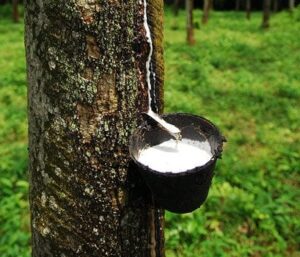Cambodia’s rubber latex exports flat for first two months of 2022
Phnom Penh, Cambodia – Cambodia exported more than $76 million in rubber latex in the first two months of 2022, according to data released by the Ministry of Agriculture, Forestry and Fishery’s General Directorate of Rubber.
The directorate said the total export of rubber latex in January-February was 48,509 tons, raking in $76.88 million. The average price of rubber during this period was $1,585 per tons, indicating a minor decrease over the same period last year.
Directorate chief Him Aun told The Post on March 27 that the situation around rubber latex and wood exports showed “few positive signs” in January-February.
The average price of Cambodian latex on the international market was down around one per cent year-on-year, Aun said, although he predicted that domestic demand is set to get firmer traction and drive up market rates for the commodity.
He elaborated that the Kingdom’s two active car tire plants – in Svay Rieng and Preah Sihanouk provinces – have yet to source local latex as planned, relying instead on imported compounded rubber, due to a lack of necessary equipment to make the raw material in-house.
Aun disclosed that both companies have vowed to install the equipment and work with the directorate to source natural rubber locally.
Men Sopheak, CEO of rubber grower and exporter Sopheak Nika Investment Agro-Industrial Plants Co Ltd, argued that a spike in demand on the international market would immediately drive up the price of Cambodian rubber, given the local market’s dependence on the global stage.
New and existing processing plants would need to expand total capacity substantially for the domestic rubber market to garner the desired strength, he stressed. “The market will only be strong if Cambodia has more rubber processing factories that can supply both the domestic and export markets,” he said.
Cambodia Chamber of Commerce (CCC) vice-president Lim Heng told The Post that in recent years, investment in rubber has shown little progress because the price of Cambodian rubber is based entirely on international markets. The Kingdom’s data is therefore by and large based on export figures. These two factors mean rubber has hardly been an attractive investment.
He opined, however, that last year’s inauguration of Cart Tire Co Ltd’s car tire plant, chiefly geared towards exports, would lead to a gradual rise in investment.
“We expect that new investments in tyre factories and the opening of car assembly plants in Cambodia will ratchet up demand for rubber, with a corresponding increase in prices,” he said.
The directorate reports that as of 2021, the Kingdom had 404,044ha dedicated to rubber production, with 310,193ha or 76.77 per cent mature and tapped for latex. Aun remarked that the area under rubber cultivation has not seen significant changes in the past “two or three years”.
Cambodian rubber latex and wood exports topped $611,770,814 in 2021, climbing up from $482 million a year earlier.
Broken down by category, 366,300 tonnes of natural rubber latex accounted for $610,255,800, and 454 cubic metres of rubber wood clocked in at $1,515,015, the directorate reported.

